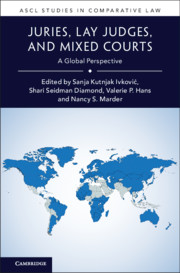Book contents
- ASCL Studies In Comparative Law
- Juries, Lay Judges, and Mixed Courts
- Copyright page
- Contents
- Editors
- Contributors
- Acknowledgments
- 1 Introduction
- Part I Advances in Lay Participation
- 2 The Rise of the Jury in Argentina
- 3 Twelve Years of Mixed Tribunals in Argentina
- 4 Lay Participation in the Criminal Trial in Japan
- 5 The Korean Jury System
- 6 The Twenty-Fifth Anniversary of the Spanish Jury
- Part II Enduring Systems of Lay Participation
- Part III Challenges to Lay Participation in Law
- Part IV Global Perspectives on Lay Participation
- Name Index
- Subject Index
- References
2 - The Rise of the Jury in Argentina
Evolution in Real Time
from Part I - Advances in Lay Participation
Published online by Cambridge University Press: 03 August 2021
- ASCL Studies In Comparative Law
- Juries, Lay Judges, and Mixed Courts
- Copyright page
- Contents
- Editors
- Contributors
- Acknowledgments
- 1 Introduction
- Part I Advances in Lay Participation
- 2 The Rise of the Jury in Argentina
- 3 Twelve Years of Mixed Tribunals in Argentina
- 4 Lay Participation in the Criminal Trial in Japan
- 5 The Korean Jury System
- 6 The Twenty-Fifth Anniversary of the Spanish Jury
- Part II Enduring Systems of Lay Participation
- Part III Challenges to Lay Participation in Law
- Part IV Global Perspectives on Lay Participation
- Name Index
- Subject Index
- References
Summary
This chapter examines the rise of the Argentine jury. Although promised in the 1853 National Constitution, the jury did not come to Argentina until the provinces took the lead in the twenty-first century. Responding to public distrust in the legal system, scholars and reformers saw the jury as a way to bring transparency, efficiency, and democratization to a judicial system rooted in the inquisitorial tradition. The chapter looks at the various choices each province has made in designing its jury trials and the distinctive features of equal gender representation and an indigenous jury introduced in Argentina. Although the reformers who advocated juries faced opposition, they overcame resistance, and appellate courts have rejected challenges to the new jury systems. Moreover, early research reveals positive reactions from the jurors, judges, and attorneys who have participated in jury trials in Neuquén and the province of Buenos Aires, and new provinces have been joining the move to implement jury systems. Other countries in Latin America have expressed interest in Argentina’s jury activities. Further developments will bear watching.
- Type
- Chapter
- Information
- Juries, Lay Judges, and Mixed CourtsA Global Perspective, pp. 25 - 46Publisher: Cambridge University PressPrint publication year: 2021

